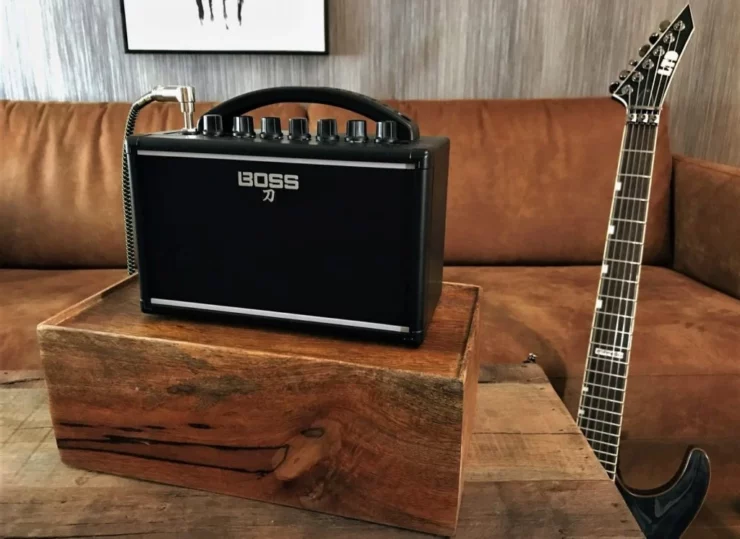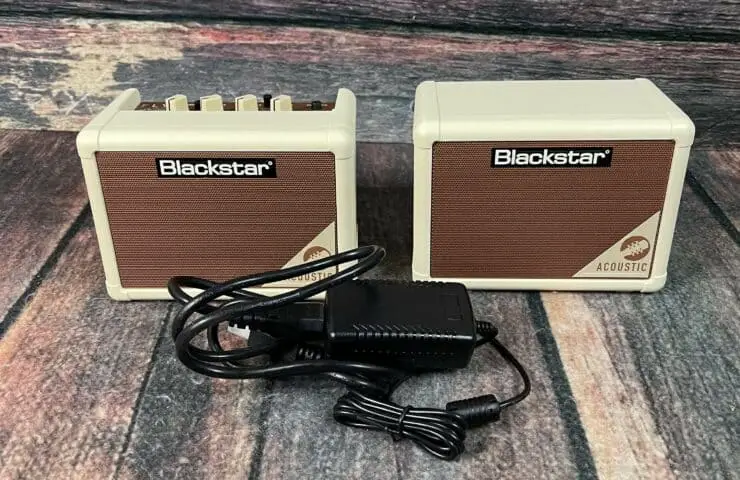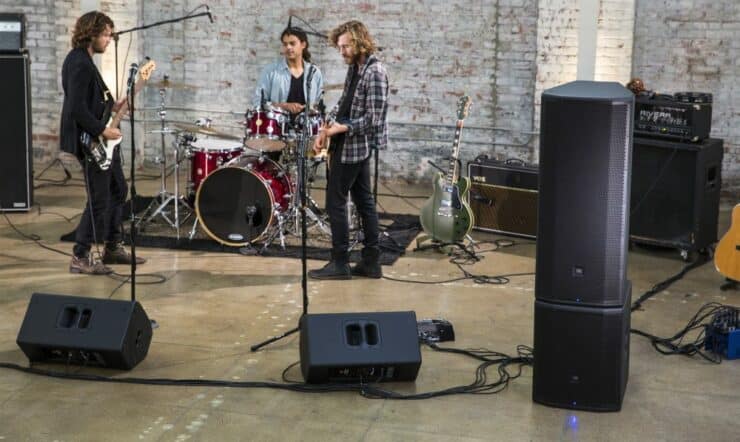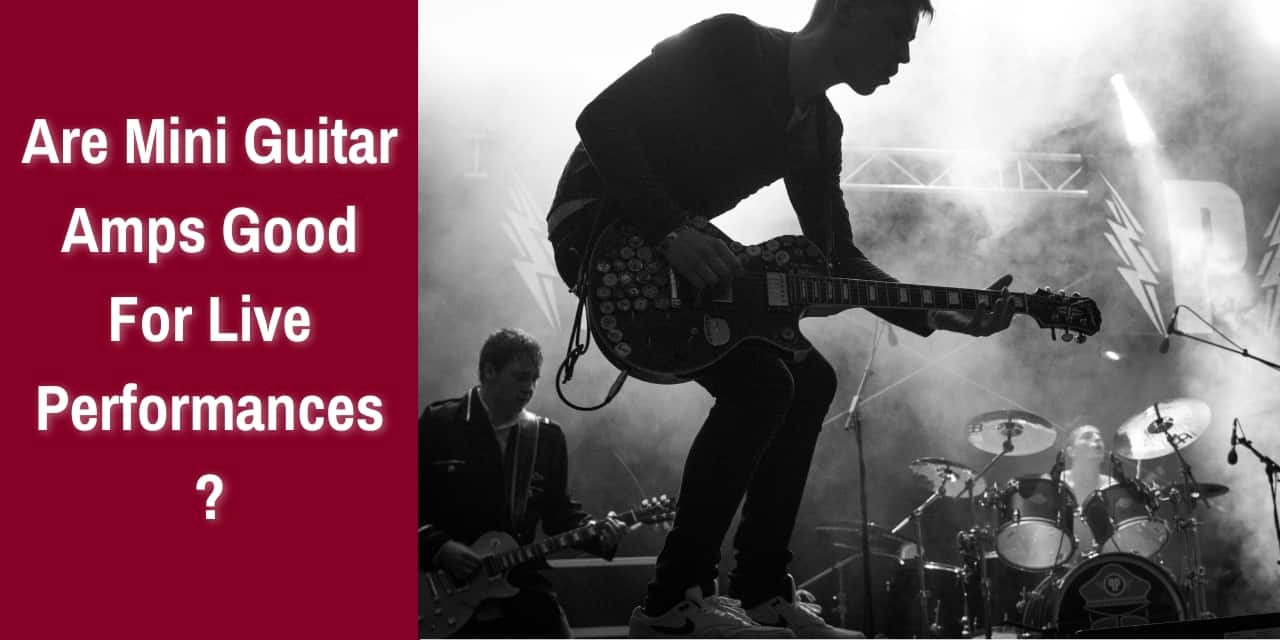If you’re a guitar player looking to take your live performances to the next level, you’ve probably asked yourself: “Are mini guitar amps good for live performances?” The answer is yes – but there’s a lot more to consider when it comes to using mini guitar amps live. In this article, we’ll explore the advantages and disadvantages of mini guitar amps and help you decide if they are right for you. Read on to learn the ins and outs of mini guitar amps and how they can help you take your performance to the next level.
Mini guitar amps for live performances
When it comes to live performance musicians and guitarists are always looking for reliable equipment that allows them to deliver their best sound without sacrificing portability. This is where mini guitar amps come into the picture.
A mini guitar amp is a compact, versatile, and essential tool for musicians and guitarists on stage. It is designed for replicating the sound of larger, traditional amps in a smaller and more portable package. These amps are typically smaller in size, lighter in weight, and often battery-powered, which makes them an ideal option for guitarists who frequently perform on the go or in smaller venues. These musical devices are quite important for live performances thanks to their portability, space efficiency, quick setup, easy operation, and a variety of sound options. Brands like Boss, Vox, etc. are known for their stunning lineups of mini guitar amps.
>>> Click here to read our review about the Top 15 Best Mini Guitar Amps <<<
One of the biggest selling points of the mini guitar amps sold by these brands is their portability. They are pretty easy to carry and transport, which allows musicians and guitarists to bring their signature sound wherever they go. Whether it is a small gig, a jam session with friends, or outdoor performances, mini guitar amps offer the convenience and flexibility needed for musicians on the move.
In venues with limited stage space, mini guitar amps offer a compact solution without having to compromise sound quality. These amps can easily fit on small stages, which makes them an amazing choice for intimate performances or crowded venues where every inch of space matters.
They are designed for simplicity. They are quite straightforward to set up and operate, enabling musicians and guitarists to focus on their performance instead of spending excessive time adjusting complex controls or dealing with cable management. This ease of use will allow for a seamless transition from practice to live performance.
Despite their smaller size, mini guitar amps offer a surprising range of tonal options and built-in effects. Many mini guitar amp models feature multiple channels, EQ controls, and effects such as delay, reverb, and distortion. This versatility will empower you to experiment with different sounds and tailor their tone to suit various musical styles and genres.
Benefits of mini guitar amps
Mini guitar amps allow musicians and guitarists to move freely on stage without being tied down by bulky equipment. With the amp placed nearby or on a stand, guitarists can interact with their audience, engage in energetic performances, and showcase their skills with enhanced stage presence.
In live performances, controlling stage volume will be important for achieving a balanced sound. Mini guitar amps offer adjustable volume settings, allowing guitarists to dial in the perfect level without empowering other instruments or causing unwanted feedback. This level of control ensures a harmonious mix and a more enjoyable experience for both the performers and the audience.
Mini guitar amps often include headphone jacks and auxiliary inputs, allowing guitarists to monitor their sound and practice silently. Additionally, some models offer Bluetooth or line-in connections, allowing musicians to play along with backing tracks or pre-recorded material. This feature enhances rehearsal sessions and provides an avenue for personalization during live performances.
These amps serve as a reliable backup option in case of equipment failure during live shows. Their compact size and portability make them quite easy to carry as a spare amp, providing peace of mind for guitarists and ensuring uninterrupted performances.
Are mini guitar amps good for live performance?
If you’re a beginner musician or guitarist in a budding band, it is common to wonder are mini guitar amps good for live performance. A mini guitar amp amplifies the guitar’s sound and allows you to adjust the tone and volume of the sound. Interestingly, mini guitar amps are commonly used for practicing and playing at home or in small venues. The sound quality might not be as good as a larger amp or a dedicated speaker and you might not have to adjust the settings to get the best sound.
Unfortunately, a mini guitar amp isn’t enough to have to carry out a full-fledged live performance on the stage. Most of the mini guitar amps come with less than 10W, which is nowhere enough to shine onstage. These guitar amps are designed for use at home and some of them sound pretty loud in smaller spaces. If you put a mini guitar amp at a large venue, it can quickly get swallowed up by the drums, PA system, bass, and other guitars.
Pros of using mini guitar amps for live performance
When it comes to live performances, the choice of guitar amplification is important for delivering a powerful and captivating sound. Mini guitar amps have gained popularity among musicians for their compact size, portability, and versatility. Here are some of the primary pros of using mini guitar amps for live performances, highlighting the benefits that they offer to guitarists on stage.

#1. Portability and ease of transport
One of the most significant benefits of mini guitar amps is their portability. These compact amps are designed to be lightweight and easy to carry, which makes them perfect for musicians constantly on the move.
Whether you are playing small venues, doing outdoor gigs, or traveling between shows, the portable nature of mini guitar amps will allow for hassle-free transportation and effortless setup.
#2. Space efficiency on stage
In venues with limited stage space, mini guitar amps truly shine. Their compact size ensures they take up minimal space, allowing for better organization and reducing clutter on stage.
This space efficiency becomes especially valuable when sharing the stage with other band members on dealing with smaller performance areas. With a mini guitar amp, guitarists can maximize the available space and focus on their performance without compromising on sound quality.
#3. Versatility and sound options
Despite their small size, mini guitar amps pack a punch when it comes to versatility. Many models offer a wide range of tonal options and built-in effects, allowing guitarists to explore different sounds and styles.
With features like multiple channels, EQ controls, and effects such as delay, reverb, and distortion, mini guitar amps offer ample room for sonic experimentation. This versatility will allow guitarists to tailor their tone to specific songs or genres, making each live performance a unique sonic experience.
#4. Quick setup and ease of use
When it comes to live performances, efficiency will be key. Mini guitar amps excel in this aspect, offering quick setup and easy operation. These amps are designed with simplicity in mind, allowing guitarists to focus on their performance rather than spending excessive time on complex configurations.
With straightforward controls and intuitive interfaces, mini guitar amps offer a seamless transition from practice to live performance, ensuring a stress-free and smooth experience on stage.
#5. Controlled stage volume
Maintaining a balanced sound mix on stage is important for a successful live performance. Mini guitar amps offer guitarists control over their stage volume, allowing them to find the perfect balance with other instruments.
With adjustable volume settings, guitarists will be able to dial in the appropriate level without overpowering or being drowned out by the rest of the band. This level of control will ensure a cohesive and well-balanced sound, enhancing the overall performance for both musicians and the audience.
#6. A reliable backup option
Mini guitar amps can serve as a reliable backup option during live performances. Their small size makes them quite easy to carry as spare amps provide peace of mind in case of any equipment failures or technical difficulties. Having a backup solution readily available will ensure uninterrupted performances and help maintain professionalism on stage.
Cons of using mini guitar amps for live performances
Mini guitar amps have gained popularity among musicians for their compact size, versatility, and portability. However, like any piece of equipment, they also come with their own set of drawbacks. Here are some of the cons of using mini guitar amps for live performances, letting you know the limitations and challenges that guitarists might encounter when relying on these amps on stage.
#1. Limited power and output
One of the main limitations of mini guitar amps is their relatively lower power and output compared to larger, traditional amps. Due to their compact size, these amps often have smaller speakers and less wattage, which can result in a limited sonic presence.
In larger venues or settings with high stage volume requirements, mini guitar amps might struggle to provide enough projection and volume, potentially leading to a loss of impact in the overall sound mix.
#2. Lack of tonal depth
While many mini guitar amps offer a wide range of tonal options, the smaller speaker size and reduced internal components can limit the depth and richness of the guitar’s tone.
The inherent design compromises made for portability and compactness can result in a somewhat compressed or limited sonic palette. This might pose challenges for guitarists looking to achieve a broader tonal range of specific sonic characteristics that are better achieved with larger and more powerful amps.
#3. Limited control and adjustability
Mini guitar amps often have simplified control layouts to accommodate their smaller size. While this simplicity can be an advantage for quick setup and ease of use, it can also limit the level of control and adjustability available to guitarists.
Features like complex EQ options, nuanced gain controls, or extensive effects routing might be reduced or absent in mini guitar amps. This lack of control might hinder guitarists who prefer more intricate and precise sound-shaping capabilities during live performances.
#4. Potential for feedback and unwanted noise
Due to their compact size and sometimes lower-quality components, mini guitar amps might be more susceptible to feedback and unwanted noise, especially when used in high-volume situations or with high-gain settings.
The limited shielding and insulation found in some models can contribute to increased noise interference, potentially impacting the overall sound quality and performance experience.
#5. Limited connectivity options
Mini guitar amps might have limited connectivity options compared to their larger counterparts. This can restrict the ability to integrate with external effects pedals, loopers, or other audio equipment commonly used in live performances.
Moreover, the absence of certain connection types (such as effects loops or XLR outputs) might limit the flexibility and compatibility with existing setups or sound systems, potentially needing additional adaptors or workarounds.
Different types of mini guitar amps
When it comes to live performances, mini guitar amps have become a go-to solution for guitarists looking for portability, convenience, and versatility without sacrificing sound quality. These compact amps offer a wide range of options to suit various musical styles, venues, and performance requirements. Here are the different types of mini guitar amps available for live performances –

#1. Tube-driven mini guitar amps
Tube-driven mini guitar amps or also known as valve amps employ vacuum tubes to amplify the guitar signal. These amps are revered for their warm, organic, and dynamic tones, which makes them a popular choice among guitarists who seek vintage or classic sounds.
These amps excel at delivering rich overdrive, harmonically complex tones, and responsive touch sensitivity. While they might require more maintenance and come with a higher price tag, the tonal rewards make them highly desirable for players in genres like rock, blues, or classic rock.
#2. Solid-state mini guitar amps
Solid-state mini guitar amps utilize transistor-based circuitry to produce their sound. These amps are known for their durability, affordability, and low maintenance requirements. They offer a clean and precise tone, which makes them suitable for genres that require accuracy and clarity, such as funk, jazz, or country.
Solid-state mini guitar amps can also incorporate digital modeling technology to emulate the sound of larger, high-end amplifiers, providing a versatile range of tones in a compact package.
#3. Digital modeling mini guitar amps
Digital modeling mini guitar amps harness advanced digital processing technology to simulate the sound characteristics of various amps, cabinets, and effects. These amps offer a vast selection of amp models, effects, and tonal options, allowing guitarists to explore different sounds and genres within a single unit.
These mini guitar amps provide the flexibility to dial in anything from vintage classics to modern high-gain tones. They are a great option for guitarists who require a wide sonic palette, versatility, and the ability to replicate specific amp tones with ease.
#4. Hybrid mini guitar amps
Hybrid mini guitar amps combine the best of both worlds by incorporating both solid-state and tube-driven components. These amps often feature a solid-state preamp section for precise tone shaping and a tube power amp section for warmth and natural overdrive characteristics.
Hybrid mini guitar amps deliver the tonal benefits of tube-driven amps while providing the reliability, affordability, and compactness of solid-state designs. They offer a compromise between tonal authenticity and practicality, making them ideal for various genres and live performance scenarios
#5. Battery-powered mini guitar amps
Battery-powered mini guitar amps are designed for ultimate portability and versatility. These amps operate on batteries, allowing guitarists to perform in locations without access to power outlets or for on-the-go performances.
These amps often come in compact sizes, which makes them easy to carry and set up. They can be a convenient choice for street performances, busking, or impromptu jam sessions. While they might have limitations in terms of power output and tonal options, their mobility and independence from electrical power sources make them highly practical for certain performance situations.
Tips for using mini guitar amps for live recording
Mini guitar amps are a great option for musicians and guitarists looking for portability and versatility without sacrificing sound quality in live performances. To maximize the potential of these compact amps, there are certain tips and techniques you’ll need to follow. Here are certain tips you’ll need to follow to get tremendous sound and seamless live performance.
#1. Set up your mini guitar amp
First, you need to place your mini guitar amp at a suitable height and angle for optimal projection and monitoring. You should consider using a guitar amp stand or placing it on a sturdy surface to elevate it above ground level and direct the sound toward your ears.
Organize your cables properly to avoid tripping hazards and unwanted noise. Make use of cable ties or Velcro straps for securing cables and keeping them tidy, preventing accidental unplugging or interference.
Make sure there is a reliable power supply for your mini guitar amp. Check the battery levels or connect it to a power outlet depending on the power source options available. Remember to carry spare batteries or power adapters for backup during performances.

#2. Adjust the tone
Start off by adjusting the gain and volume controls on your mini guitar amp. Set the gain to achieve the desired level of overdrive or distortion and adjust the volume for matching the stage volume and maintain a balanced mix with other instruments.
Experiment with the bass, treble, and midrange controls for shaping your tone. Adjust the bass for low-end warmth, midrange for presence and clarity, and treble for brightness. Find the right balance that suits your playing style and complements the band’s sound.
If your mini guitar amp includes built-in effects or additional controls, experiment with them to add depth and character to your sound. Experiment with reverb, delay, modulation, or other effects to enhance your tone and create ambiance but use them sparingly to avoid overwhelming the mix.
#3. Connect to other equipment
If you use external effects pedals, connect them to your mini guitar amp using the appropriate cables and connectors. Experiment with different pedal combinations to enhance your sound and achieve the desired sonic effects.
Some mini guitar amps offer direct recording capabilities. Connect your amp’s headphone or line-out jack to an audio interface or recording device for direct recording, allowing you to capture your performance without the need for external microphones.
When performing in larger venues or through professional sound systems, connect your mini guitar amp’s line-out or direct output to the venue’s PA system or soundboard. Make use of the appropriate cables and connectors and communicate with the sound engineer to ensure the best sound quality and proper integration into the overall mix.
FAQs
Are mini guitar amps good for live performances?
Mini guitar amps can be a great option for live performances, depending on the size of the venue and the type of sound you are looking for. Mini amps are small, lightweight, and portable, allowing for easy transport and setup. However, they may not have the same power and volume as larger amps and may not be suitable for larger venues.
What are the benefits of using a mini amp for live performance?
Mini amps offer several benefits for live performance, including their portability and low cost. They are also great for practice, recording, and jamming, as they can produce a great sound in a small space.
What should I consider when choosing a mini amp for live performance?
When choosing a mini amp for live performance, it’s important to consider the size of the venue, the type of sound you are looking for, the cost, and the features available in the amp. You should also consider the amp’s power, speaker size, and tone controls, as these will determine how much volume and projection the amp can produce.



